Early Power Distribution Stations
Distribution Stations (DS) are used to transfer power from the transmission system to the distribution system for a specific service area. It is uneconomical to directly connect electricity customers to the main transmission network, unless they use large amounts of power. Therefore the distribution station reduces voltage to a value suitable for local distribution. In addition to transforming voltage, the substations regulate voltage which ensures a smoother level of power as seen by the customer.
Early Distribution Stations in Los Angeles
As Los Angeles began to grow in the early 1900s, there became an increasing need to install additional distribution stations. The following is just a sample of the many distribution stations found in Los Angeles during the 1920s and 1930s. These early stations were either built by the Bureau of Power and Light or purchased by them from the LA Gas and Electric Corporation when the city bought out the private company in 1937.
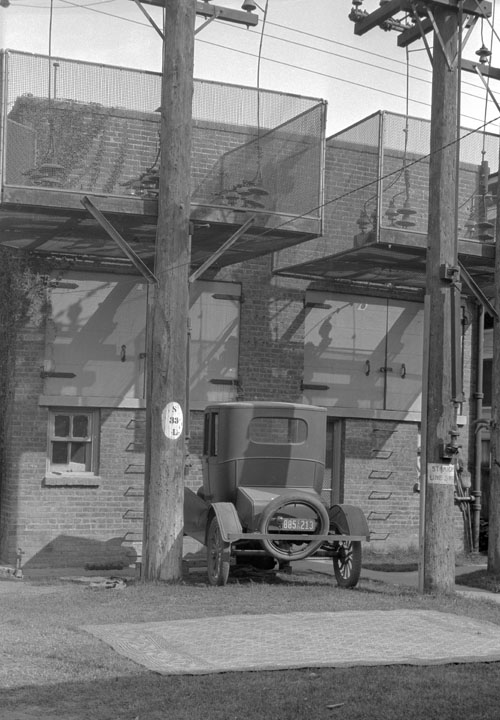 |
|
| (Early 1920s)* - View of one of the first Power Distribution Stations in the City of Los Angeles. |
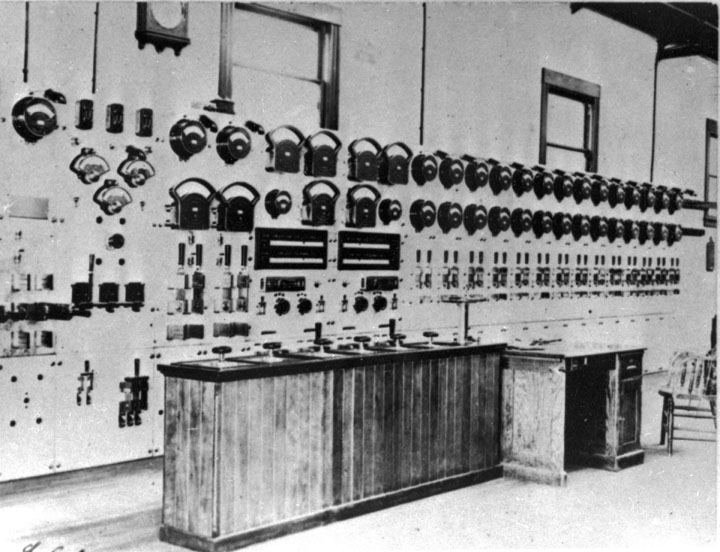 |
|
| (ca. 1920s)* - View showing a control board in an early Distribution Station. |
Historical Notes Before the advent of remote control and monitoring equipment, substations had to be manned (and until the 1970’s Operators were exclusively men) twenty four hours a day. Before World War II, almost all BP&L Distributing Stations were continuously attended; a handful of small stations, located in remote areas were operated by early supervisory equipment from nearby attended stations.^^ Click HERE to see more in Early Power Station Operations |
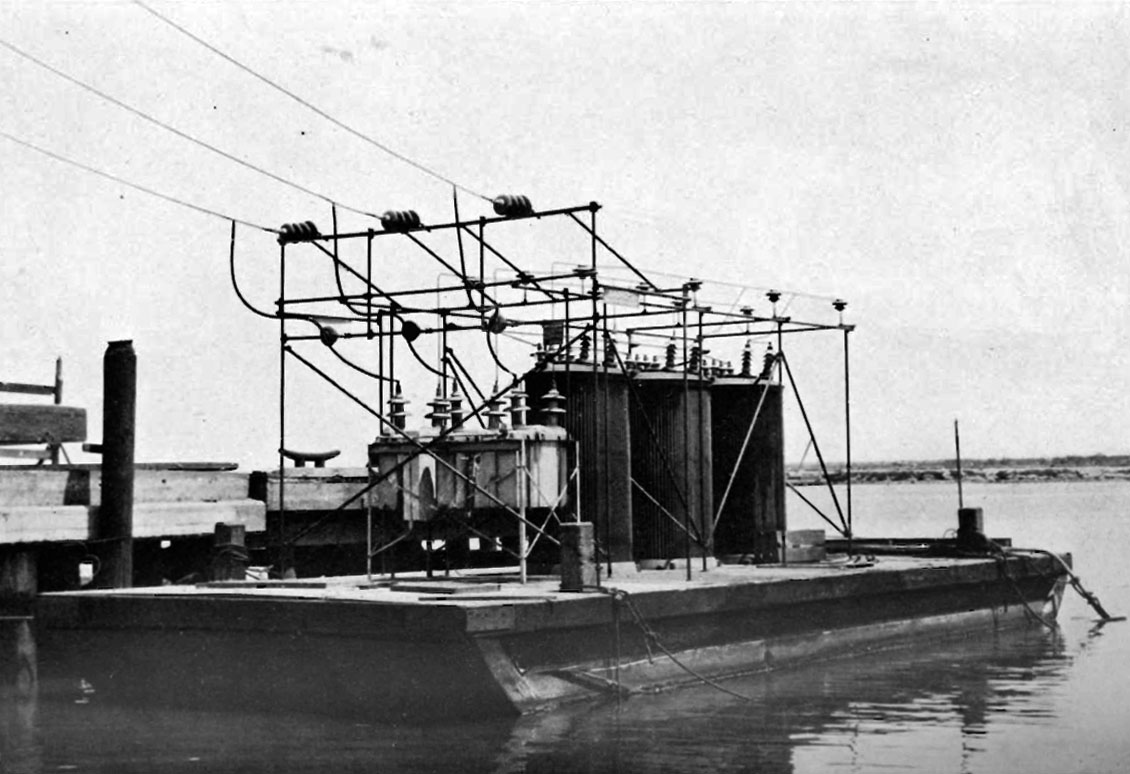 |
|
| (1924)*# – View showing a 33,000 volt Floating Distribution Station used for dredging operations at Los Angeles Harbor. |
Categories of Distribution Stations
Distribution Stations generally fell into three major categories: Permanent Stations, Semi-permanent or Portable Stations, and the stations that came to the Bureau as part of the purchase of the Los Angeles Gas & Electric Company’s electric system, .
Permanent stations were two story, with the 34.5-kV equipment on the second floor and the transformer banks and 4.8-kV equipment on the first. Most had a basement and some had 4.8-kV synchronous condensers, often in the basement. Each permanent station was “…housed in a reinforced concrete building constructed to harmonize with its surroundings and be an asset to the neighborhood.” Their architecture varied over time.
Semi-permanent stations were single story steel frame buildings. In these stations the 34.5-kV equipment was separated from the 4.8-kV equipment by a firewall. Unlike the permanent stations, they did not have a separate control room; the control board was along one side of the 4.8-kV equipment room
The stations that came to the Bureau from LAG&E were of many different architectural styles, some were brick, some concrete frame with brick infill, the most recent were poured concrete. The design of their electrical equipment was also different from BP&L practice. Many of these stations were equipped with supervisory control to allow them to be unattended or only attended on some shifts. After coming to the Bureau, they were made normally attended to make them consistent with BP&L practice.
Distribution Station No. 2
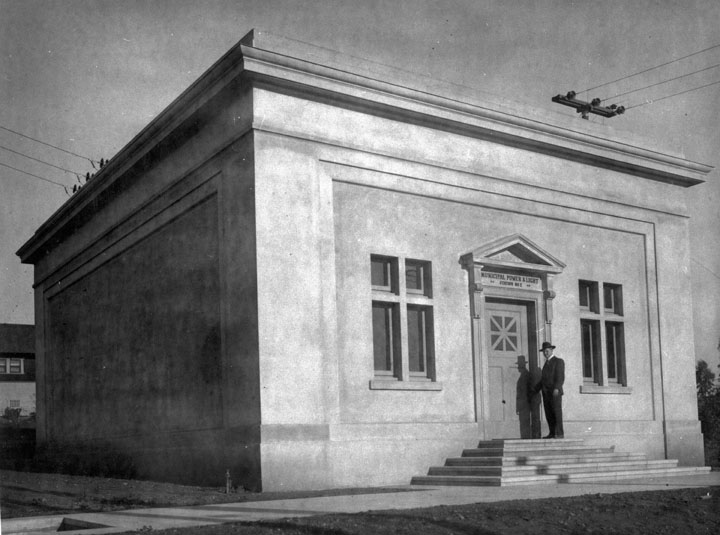 |
|
| (1916)* - Distribution Station No. 2 - Electric power was distributed to residents in the Highland Park-Garvanza areas of Los Angeles in 1916 from Distributing Station 2 located at 225 N. Avenue 61. |
Historical Notes In 1916, the first electrical energy sold and distributed by the Los Angeles Bureau of Power and Light was obtained from the Pasadena municipal system. Things would change quickly, though. In 1917, the San Francisquito Canyon Power Plant No. 1 was completed. It harnessed the energy from water running down the recently completed LA Aqueduct and generated enough power to meet the needs of the fast growing City of Los Angeles. There was also enough excess power that now could be sold back to the City of Pasadena (Click HERE to see more in Electricity on the Aqueduct). The first operator at Distribution Station No. 2 was B. F. Goodwin. |
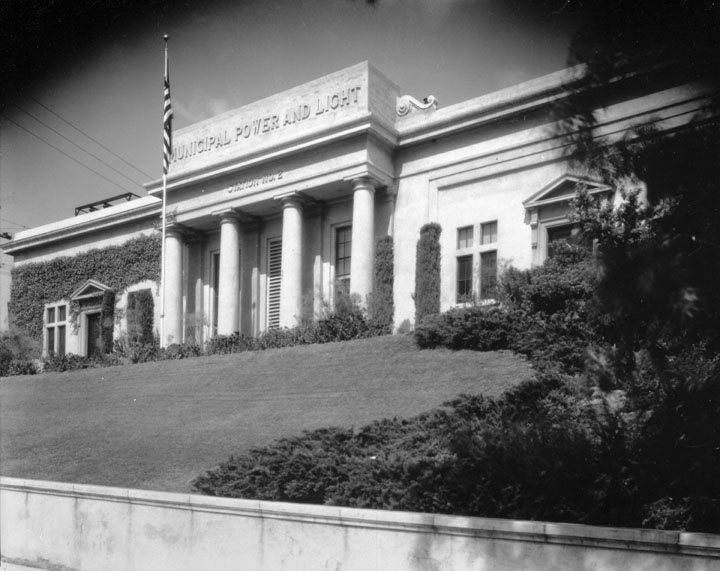 |
|
| (ca. 1920s)* - View of Distribution Station No. 2 after it was expanded. The sign on the front face of building now reads Municipal Power and Light. The Los Angeles Department of Water and Power went through six names changes since the Water Department was established in 1902. Click HERE to see Name Change Chronology of DWP. |
Historical Notes On April 21, 1962, Distribution Station No. 2 was designated Los Angeles Historical-Cultural Monument No. 558 (Click HERE to see complete listing). |
Distribution Station No. 3
 |
|
| (ca. 1920s)* - Distribution Station No. 3 - Harbor Boulevard and Regan Street, San Pedro |
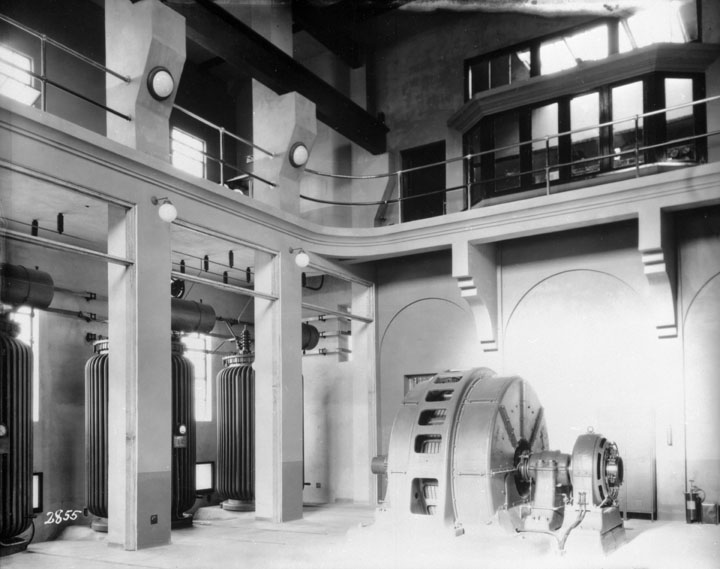 |
|
| (ca. 1920s)* - Interior view of DS-3 showing station transformers (left) synchronous condenser (right). |
Historical Notes A synchronous condenser (sometimes called a synchronous capacitor or synchronous compensator) is a device identical to a synchronous motor, whose shaft is not connected to anything but spins freely. Its purpose is not to convert electric power to mechanical power or vice versa, but to adjust conditions on the electric power transmission grid. Its field is controlled by a voltage regulator to either generate or absorb reactive power as needed to adjust the grid's voltage, or to improve power factor.*^ |
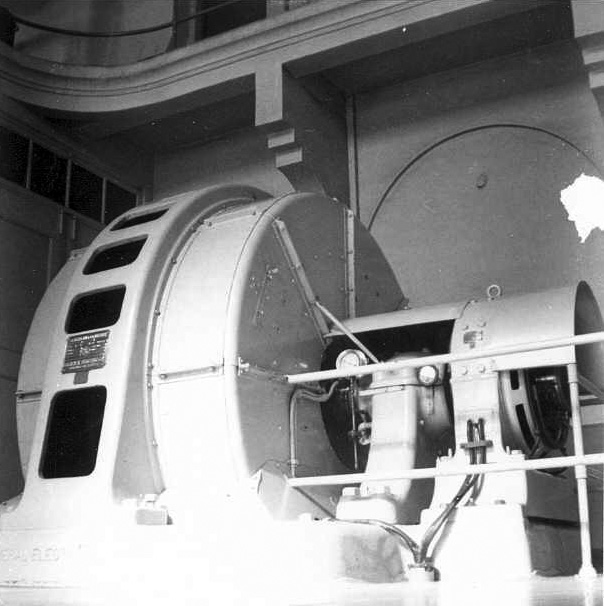 |
|
| (1959)^^ - Close-up view of the 4.8-kV 5000 KVA Synchronous Condenser at DS-3. |
Historical Notes The use of rotating synchronous condensers was common through the 1950s. They remain an alternative (or a supplement) to capacitors for power factor correction because of problems that have been experienced with harmonics causing capacitor overheating and catastrophic failures. Synchronous condensers are also useful for supporting voltage levels.*^ |
Distribution Station No. 4
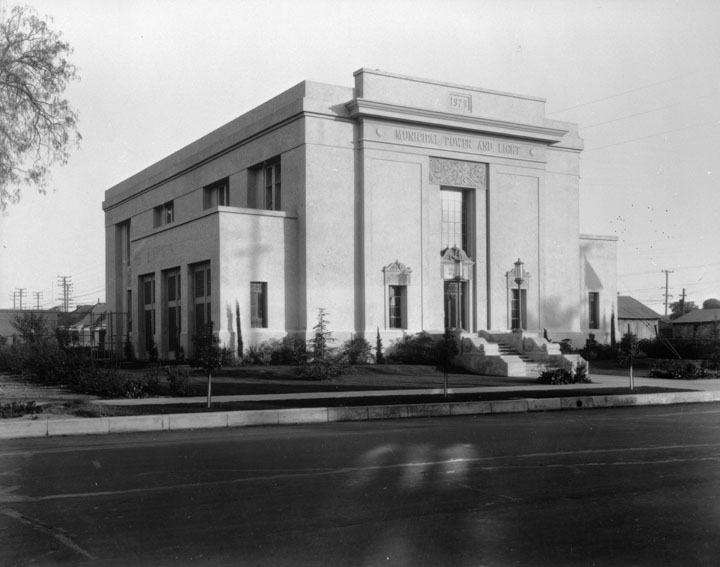 |
|
| (1928)* - Distribution Station No. 4 - 5736 South Figueroa Street |
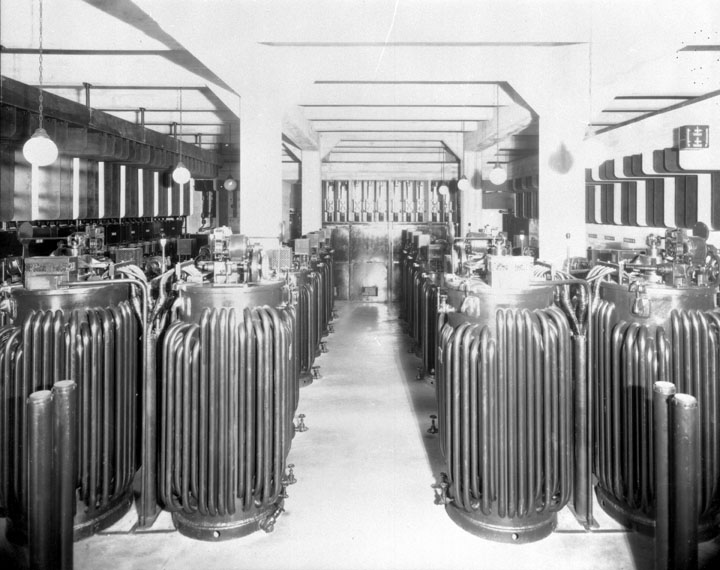 |
|
| (1928)* - Regulators at Distribution Station No. 4 |
Distribution Station No. 5
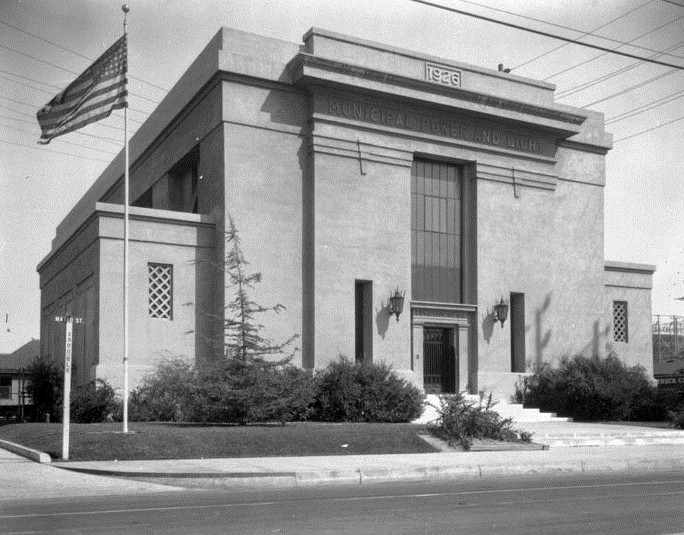 |
|
| Distribution Station No. 5 - 1504 Mateo Street |
Distribution Station No. 6
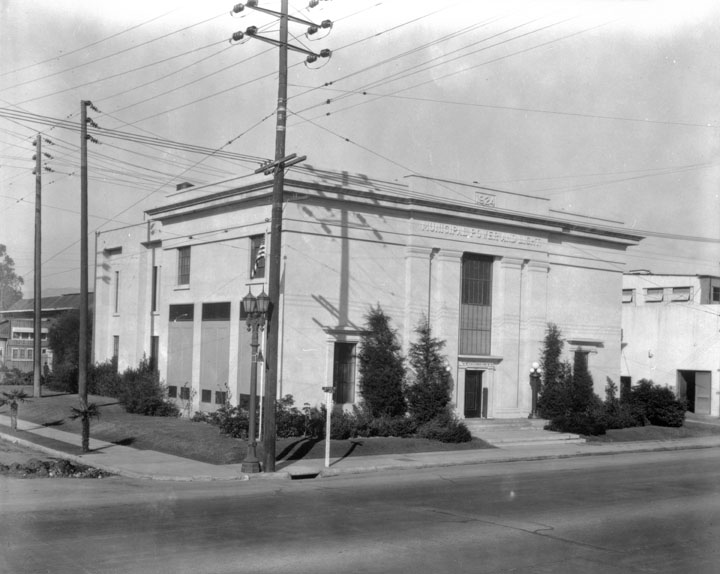 |
|
| Distribution Station No. 6 - Vine and Romaine, Hollywood. |
Distribution Station No. 7
.jpg) |
|
| (1963)* - Distribution Station No. 7 in the Civic Center. |
Distribution Station No. 8
.jpg) |
|
| (1940)* - View showing the illuminated entrance to Distribution Station No. 8 located at 4858 San Vicente Boulevard, corner of Longwood Avenue. |
LADWP Historic Archive September 1938 – Preliminary construction work is scheduled to get under way this month on one of the largest distributing stations ever built by the Bureau of Power and Light. To be designated as Distributing Station No. 8, the new station will replace a semi-permanent type station which occupies the rear portion of the lot at 4858 San Vicente Blvd, corner of Longwood Ave. it will serve the Hancock Park and West Pico Districts. |
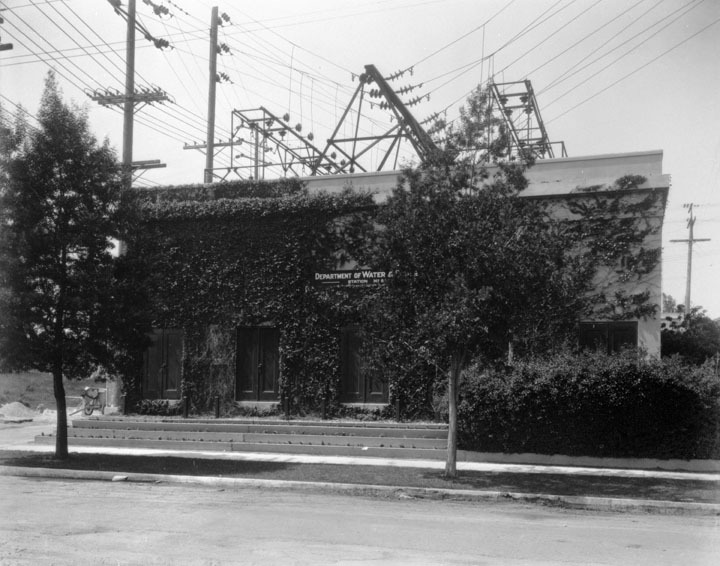 |
|
| (n.d.)* - Side view of Distribution Station No. 8 - 1389 Longwood Avenue |
Distribution Station No. 9
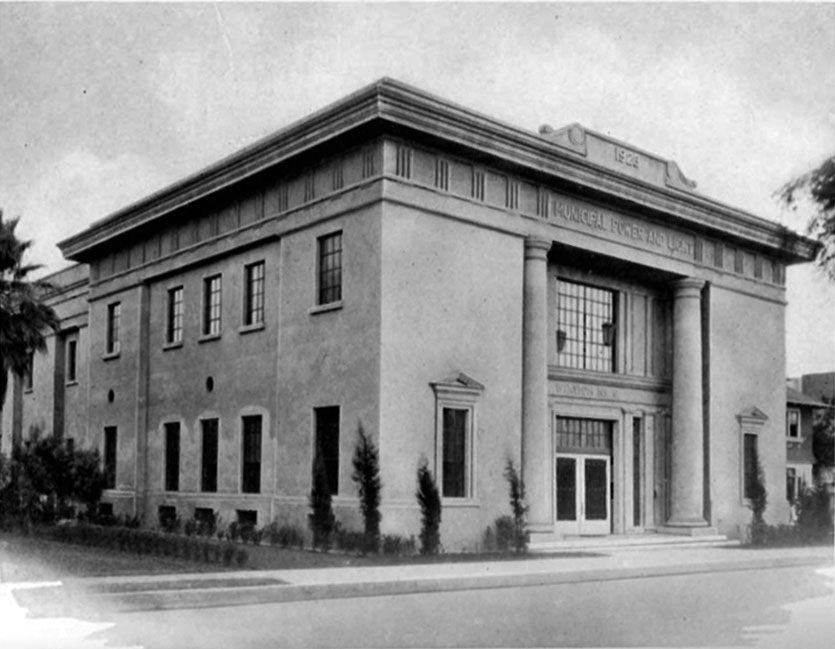 |
|
| (1924)*# – View showing the recently completed Francisco Street Distribution Station No. 9. |
 |
|
| (1924)*# - Interior view of the Francisco Street Distribution Station. |
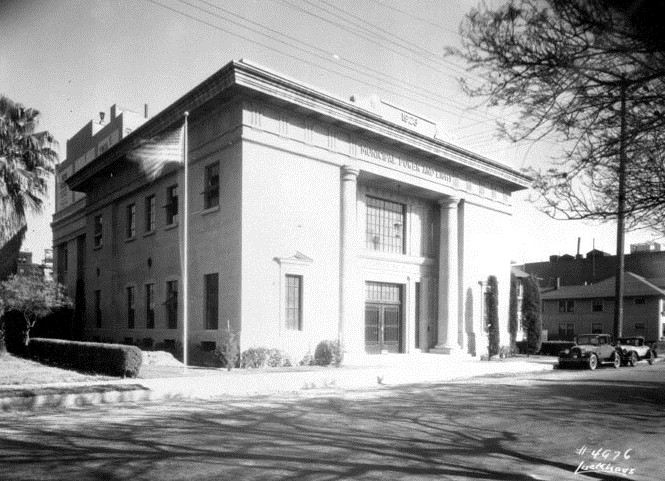 |
|
| (ca. 1930)* - Exterior view of Distribution Station No. 9 located on Francisco Street |
Distribution Station No. 10
.jpg) |
|
| (1933)* - View of the front entrance to Distribution Station No. 10, located at 6776 Hawthorne Avenue in Hollywood. |
Historical Archive May 1933 – Another vital link was added to the chain of equipment supplying light and power to Los Angeles when Distributing Station No. 10 was put into service April 20, 1933. The new addition to the Bureau of Power and Light system is located at 6776 Hawthorne Ave and will serve the important west and central sections of Hollywood. |
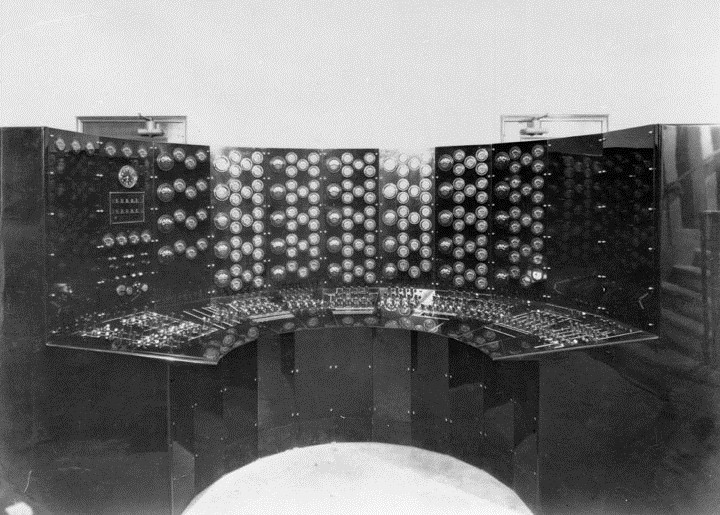 |
|
| (1933)* - Distribution Station 10 - Meter and control board which is a new type designed and built by the Bureau of Power and Light. This equipment resembles the console of a huge pipe organ. |
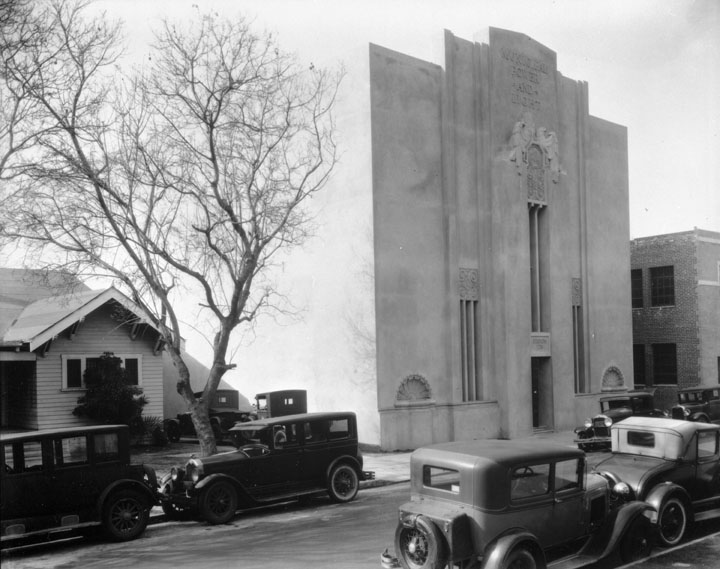 |
|
| (1933)* - Another view of Distribution Station No. 10, located in Hollywood. |
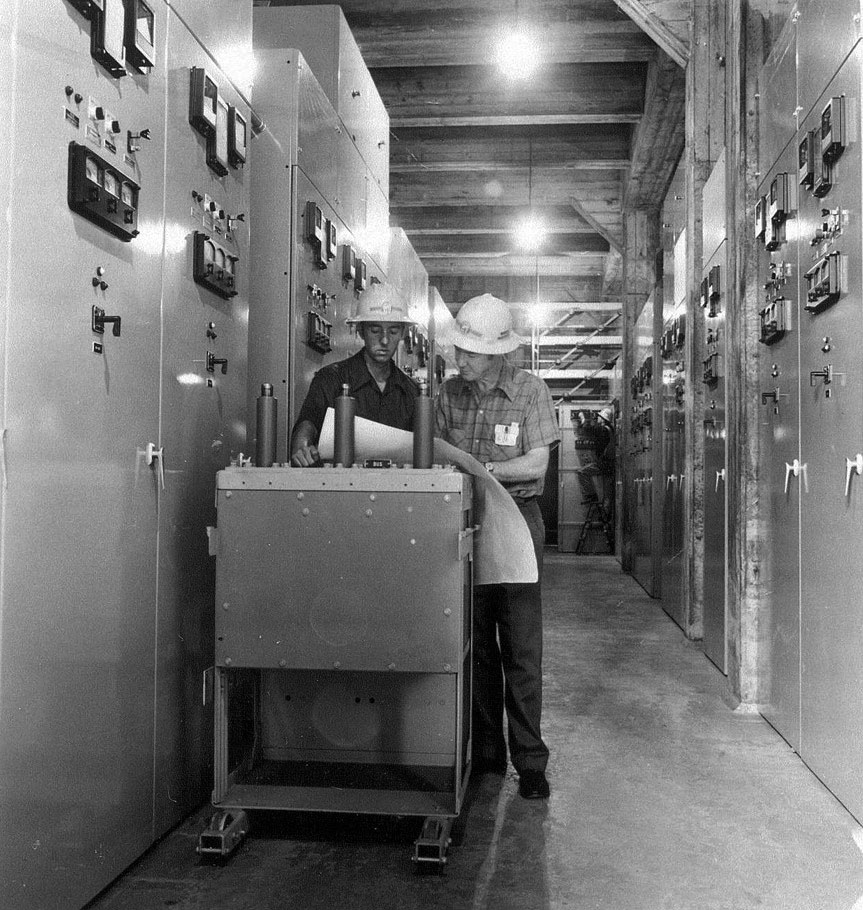 |
|
| (1973)^^ – View showing two engineers (?) looking at schematic diagrams at DS-10 Rack-in CB. |
Distribution Station No. 11
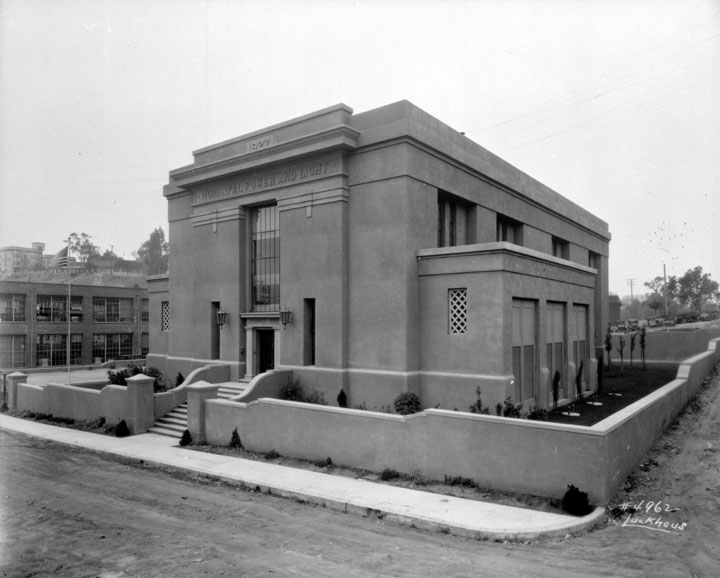 |
|
| (ca. 1928)* - View of the newly constructed Bureau of Power and Light Distribution Station No. 11. |
Distribution Station No. 12
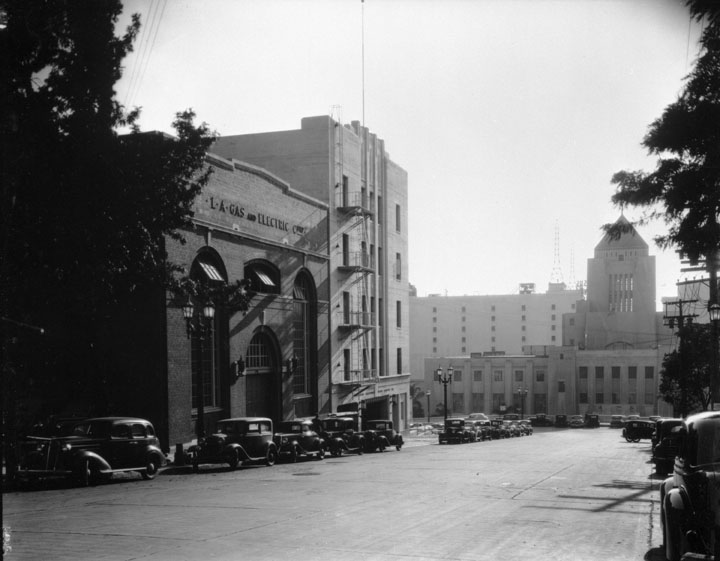 |
|
| (1927)* - View of Distribution Station No. 42 located at 428 S. Hope Street when it was still part the Los Angeles Gas and Electric Corporation. At that time it was desginated DS No. 12. |
Historical Notes In December of 1936 Los Angeles City voters approved a charter amendment authorizing the Bureau of Power and Light to issue revenue bonds in the amount of $46 million and purchase the electrical system of Los Angeles Gas and Electric Corporation. At that time, it was the last remaining privately owned system in LA (Click HERE to see more in LA Gas and Electric Corp). |
Distribution Station No. 12 (Changed to No. 42)
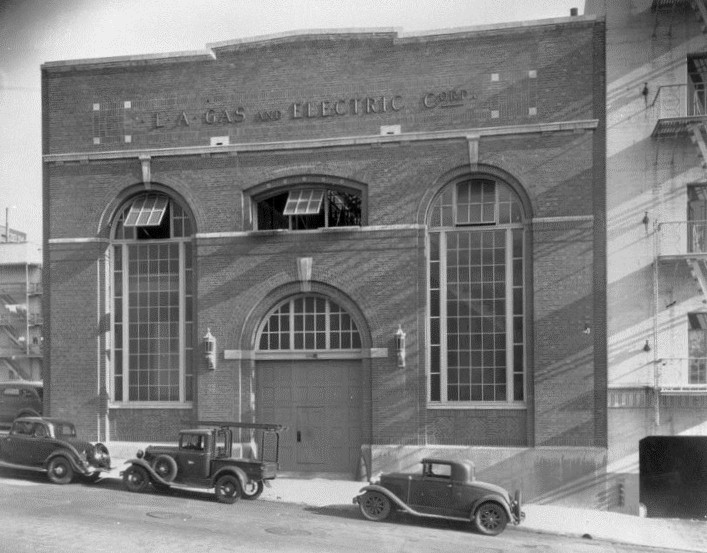 |
|
| (1927)* - Distribution Station No. 42 on Hope Street. This station was built by LA Gas and Electric Co. and originally went by the designation DS-12. The Bureau of Power and Light would re-number the station to DS-42 after it purchased LA Gas and Electric Corp. in 1937. |
Historical Notes In 1937 the Bureau of Power and Light completed the purchase of Los Angeles Gas and Electric Corporation. That same year the Bureau of Power and Light consolidated with the Bureau of Water Works and Supply and became the Los Angeles Department of Water and Power (DWP). Click HERE to see Name Change Chronology of DWP. In 1939, Southern California Edison (SCE) and DWP completed negotiations on the division of territory between the two utilities. SCE also swapped the remainder of its Los Angeles distribution system for DWP facilities outside the city limits (formerly owned by Los Angeles Gas and Electric). Click HERE to see more in First Electricity in Los Angeles. |
Distribution Station No. 13
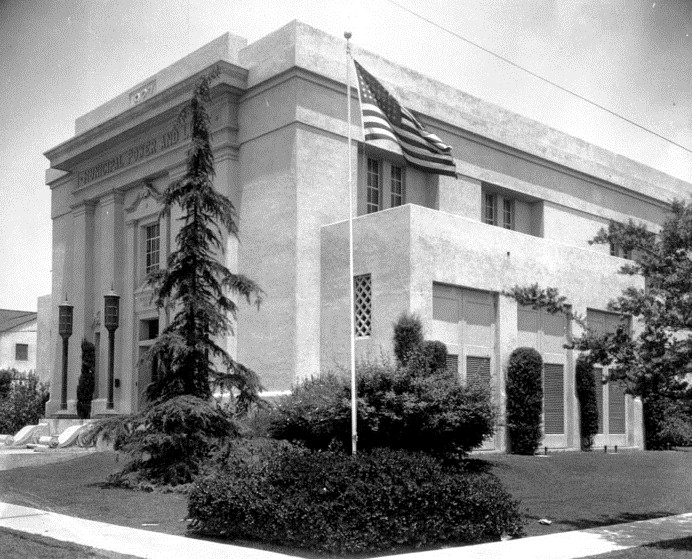 |
|
| (1928)* - View of Distribution Station No. 13 |
LADWP Historic Archive May 1928 - One of the objectives of the Engineer is to arrive at a standard type of building and a standard electrical layout that will meet both the architectural and load requirements of the diversified centers of population throughout the city of Los Angeles. at 3520 South Normandie Ave one may now see in operation the new Distribution Station No. 13 – which is representative of the very latest type of a standardized station, as developed for the Bureau of Power and Light system. Credit is to be given J. D. Laughlin for his efficient supervision of the engineering details of this plant. Five stations, of which Station 13 is the fifth, have been constructed from one set of drawings, thus effecting a great saving not alone in engineering and drafting expenditures, but also in actual construction costs, because the crews have become familiar with the standardized layout and accomplish results with greater efficiency and precision. |
Distribution Station No. 14
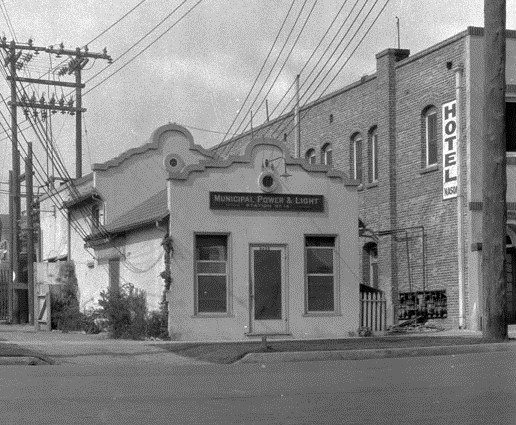 |
|
| (n.d.)* - View of Distribution Station No. 14, adjacent to a hotel. |
Distribution Station No. 17
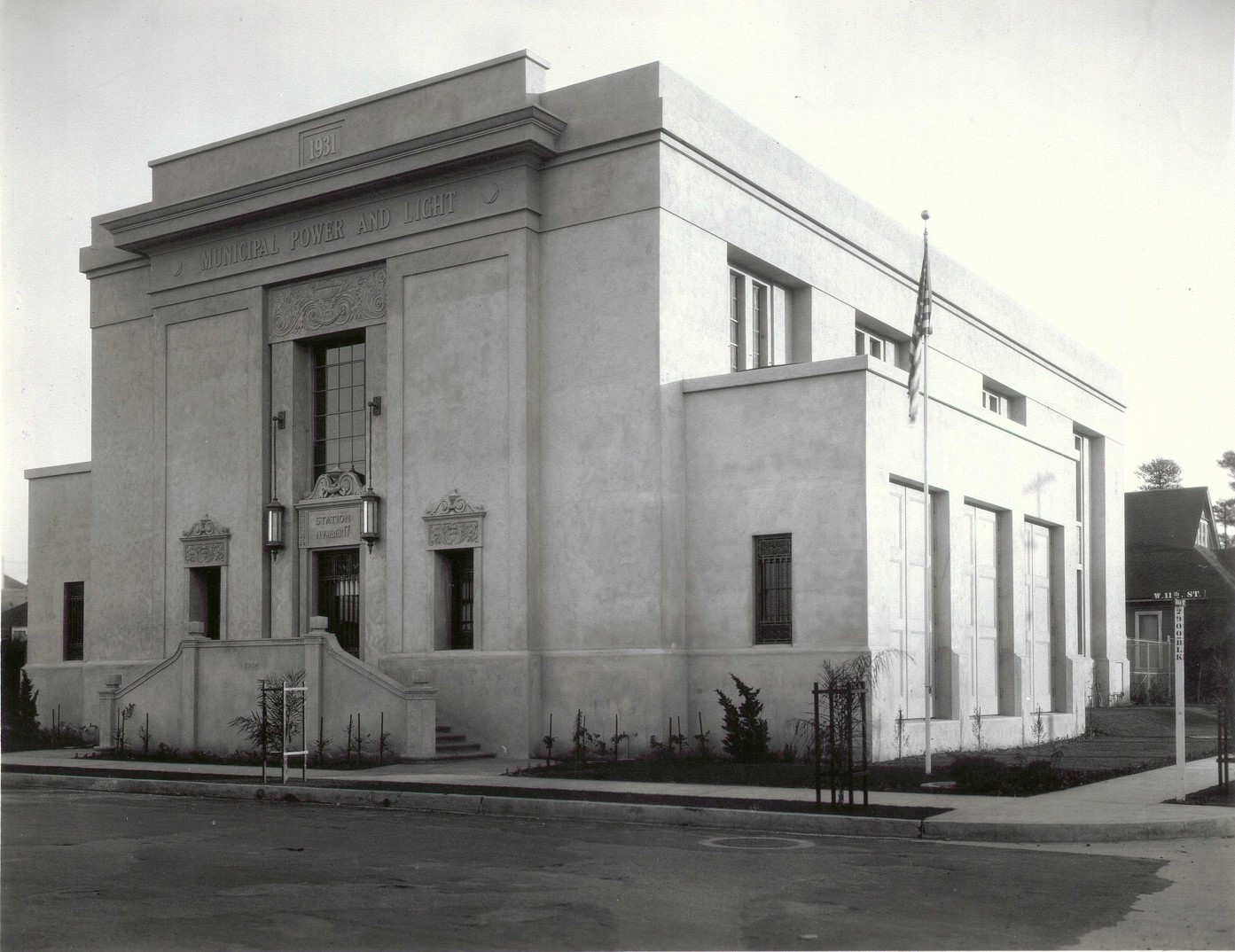 |
|
| (1930s)^^ - View showing Distribution Station No. 17 on 11th Street. |
LADWP Historic Archive Distributing Station No. 17 at 2904 West 11th Street - Ground was broken last month, (July 1930) for the new Distributing Station Number 17 which will replace the temporary sheet iron structure at 2940 West Eleventh. |
Distribution Station No. 20
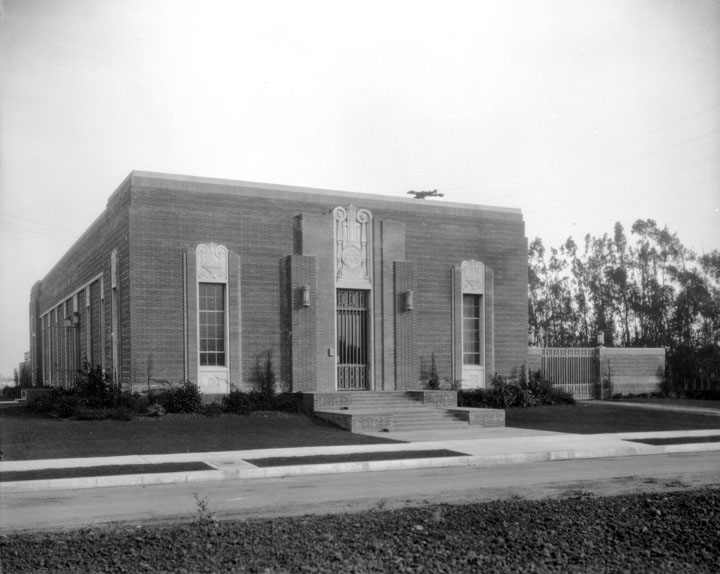 |
|
| (ca. 1930s)* - Exterior view of Distribution Station No. 20 located in Palms. |
Historical Notes LADWP Historic Archive April 1933 – preliminary work under way at Distribution Station No. 20 site in Palms, at Kincardine and Canfield Avenues, includes erection of a small bridge across a swampy depression and laying of water mains. Oliver H. Wenty, engineer of this job for Wingard, states that securing of a building permit has been delayed temporarily due to changes in layout. |
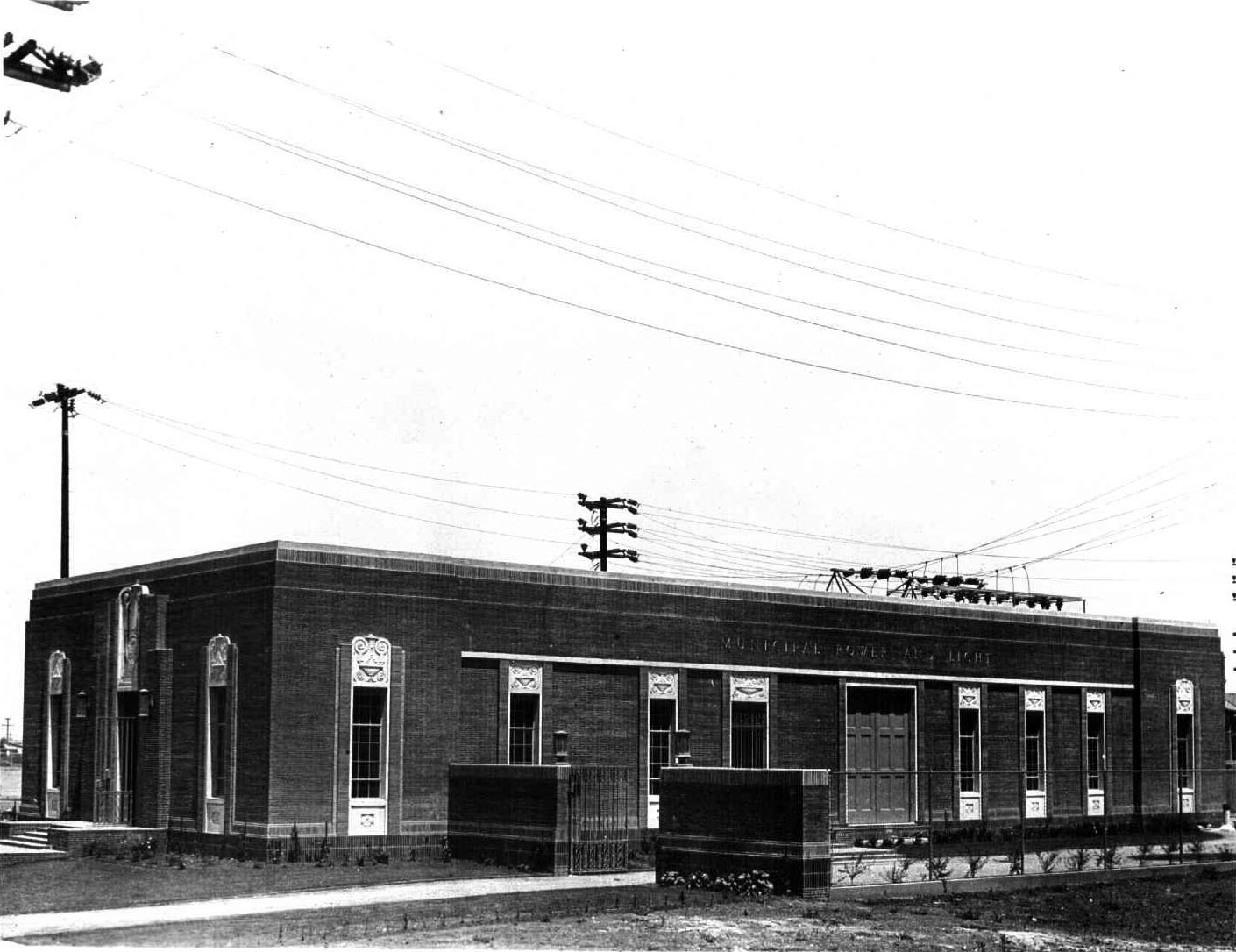 |
|
| (ca. 1934)^^ - Profile view of Distribution Station No. 20. showing overhead distribution lines surrounding the building. |
Distribution Station No. 23
.jpg) |
|
| (ca. 1930s)^^ - Senior Operator J. M. Stetzer at the control board, DS-23. |
Historical Notes The attended Distributing Stations were converted to supervisory control, beginning in the early 1950’s, with the last one going on supervisory control in the 1980’s. Today they are all controlled by Remote Terminal Units from the Energy Control Center. Click HERE to see more in Early Power Station Operations |
Distribution Station No. 26
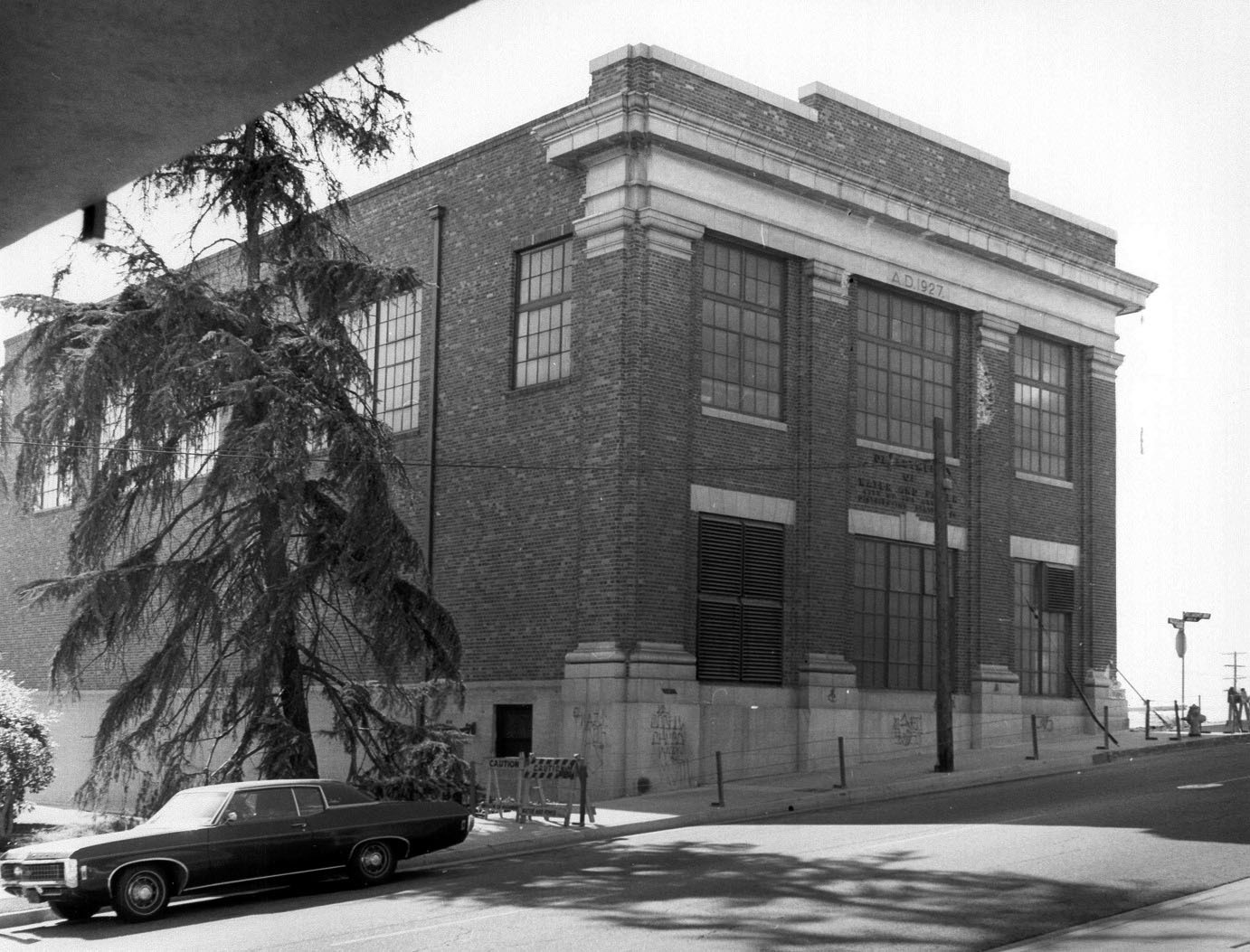 |
|
| (1971)^^ – DS-26 located at 1638 Palo Alto Street. |
Historical Notes DS-26 sustained earthquake damage during the 1971 Sylmar Earthquake. |
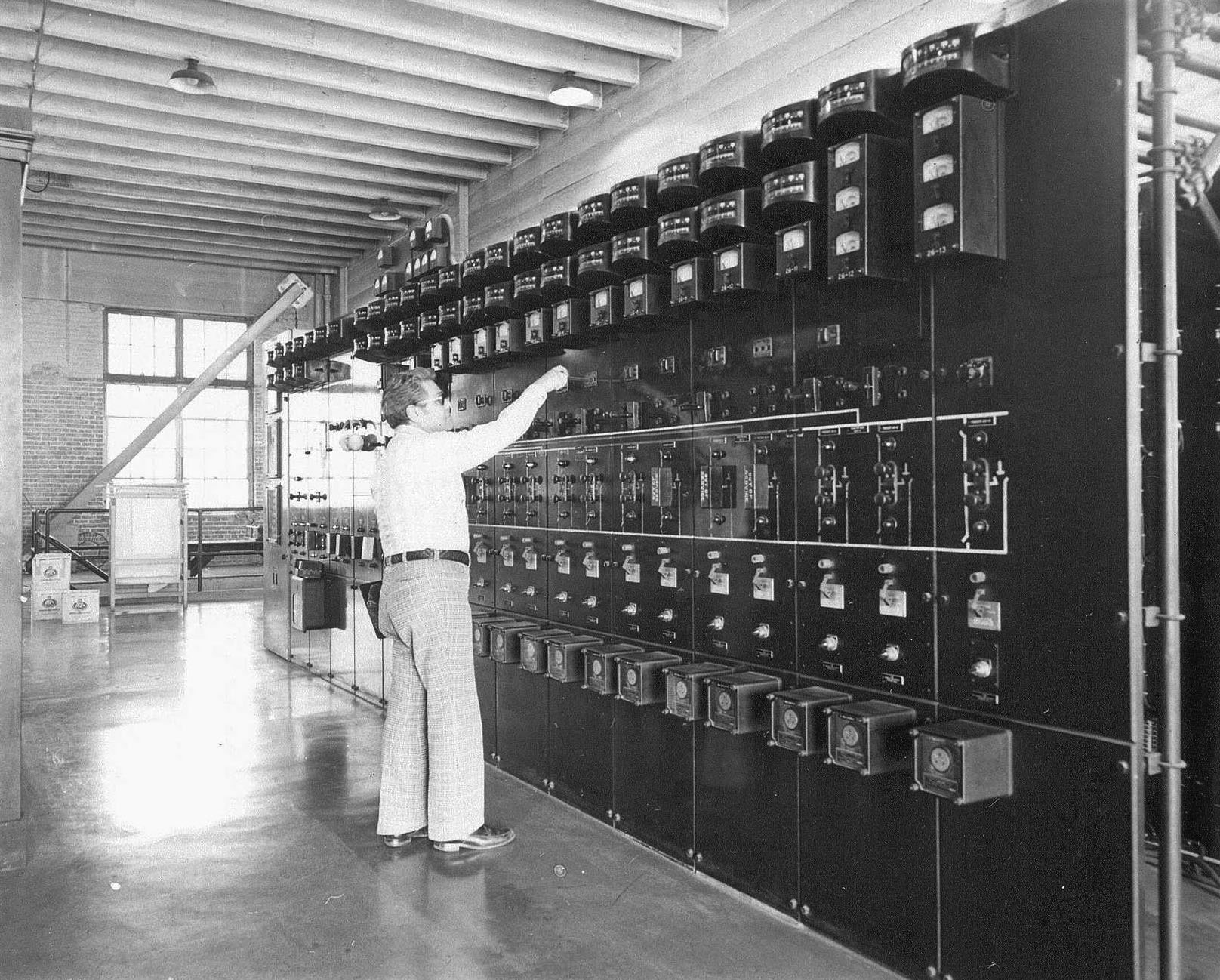 |
|
| (1975)^^ - Operator Walt Norman at the control board, DS-26. |
Distribution Station No. 28
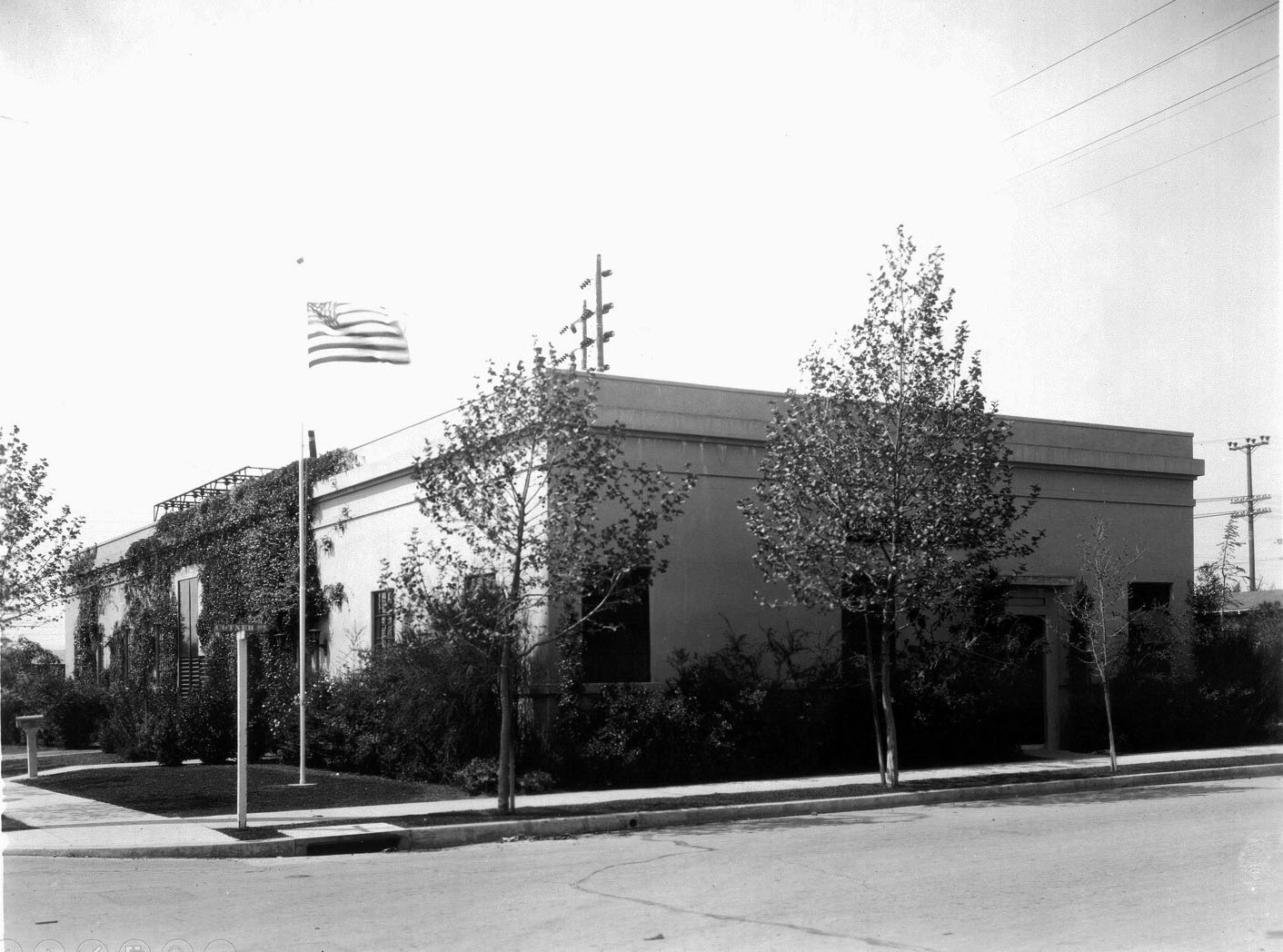 |
|
| (1938)^^ – View showing Distribution Station No. 28, located on Cotner Avenue. |
Distribution Center No. 29
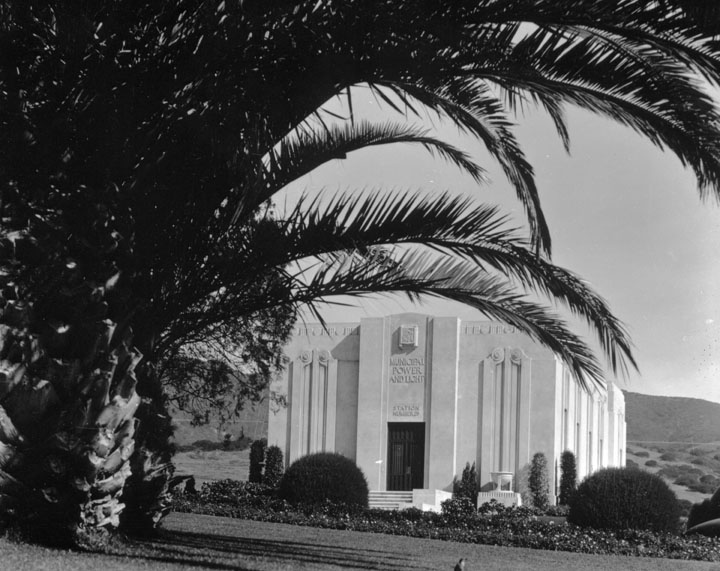 |
|
| (1935)* - Distributing Station No. 29 - 15345 Sunset Boulevard, Pacific Palisades. Built in the Regency Moderne style. |
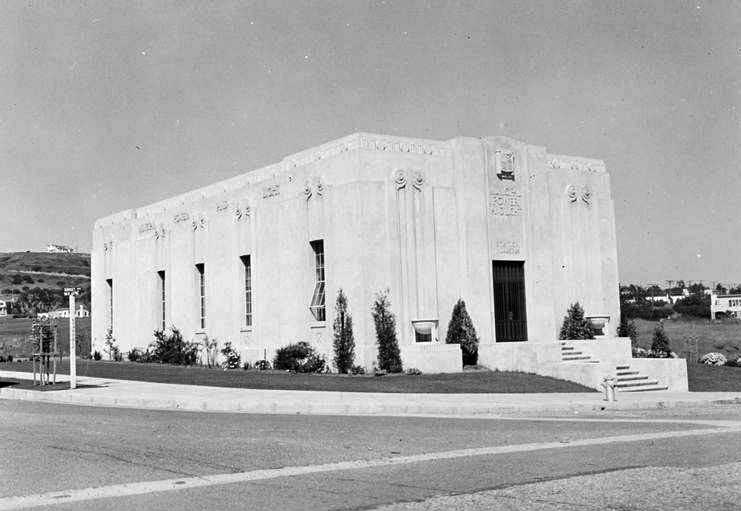 |
|
| (1945)^* - View showing Distributing Station No. 29, located on the northeast corner of Sunset and Via De La Paz. Click HERE for contemporary view. |
Distribution Station No. 30
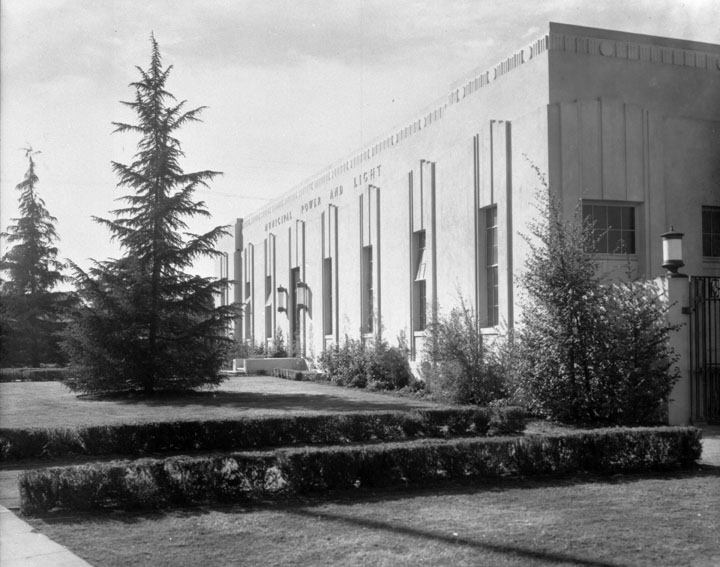 |
|
| (1936)* – View of Distributing Station No. 30 located in the Eagle Rock district. |
Historical Notes DS 30 was completed in September, 1936. At the peak of activities, approximately 100 men were employed on the job it was stated by G. E. Benkesser who was in charge of the project. Building construction was supervised by Charles Yakely and electrical installations were directed by Joe Shedlow.* |
.jpg) |
|
| (1936)* - Front view of Distributing Station No. 30. |
Distribution Station No. 35
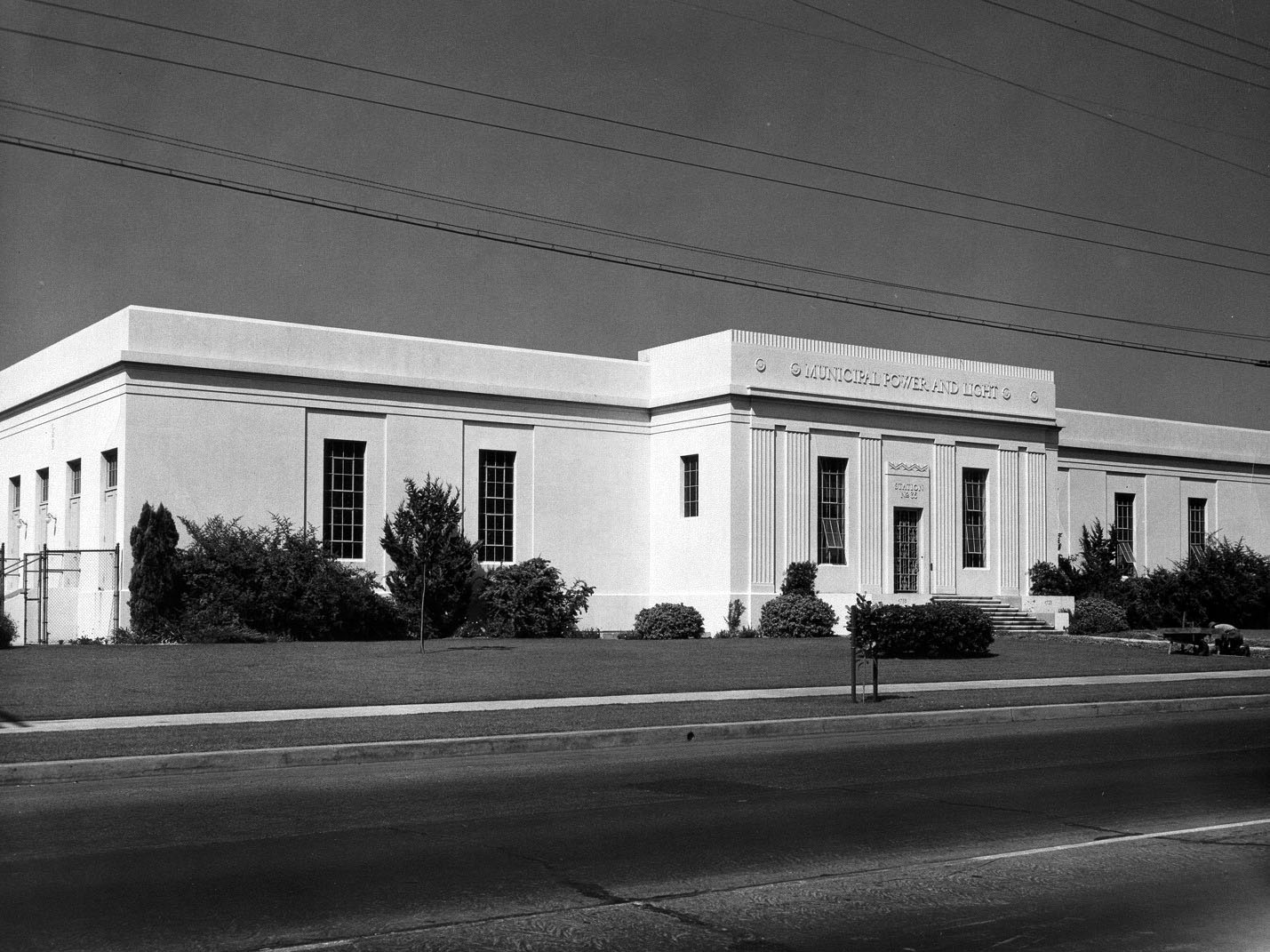 |
|
| (1949)^^ – View showing DS-35 located at 4735 Cahuenga Blvd. |
Distribution Station No. 43
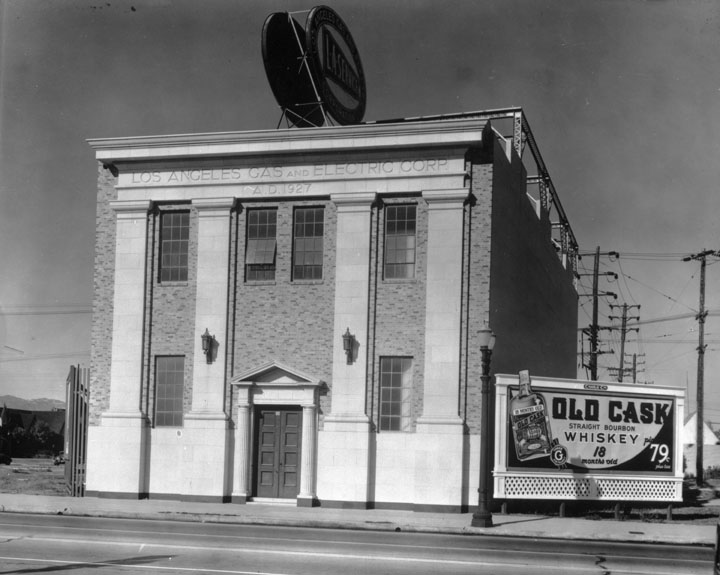 |
|
| (1930s)* - Distribution Station No. 43 - 5769 West Pico. This station was built by LA Gas and Electric Co. which was purchased by the Los Angeles Bureau of Power and Light in 1937. |
Distribution Station No. 44
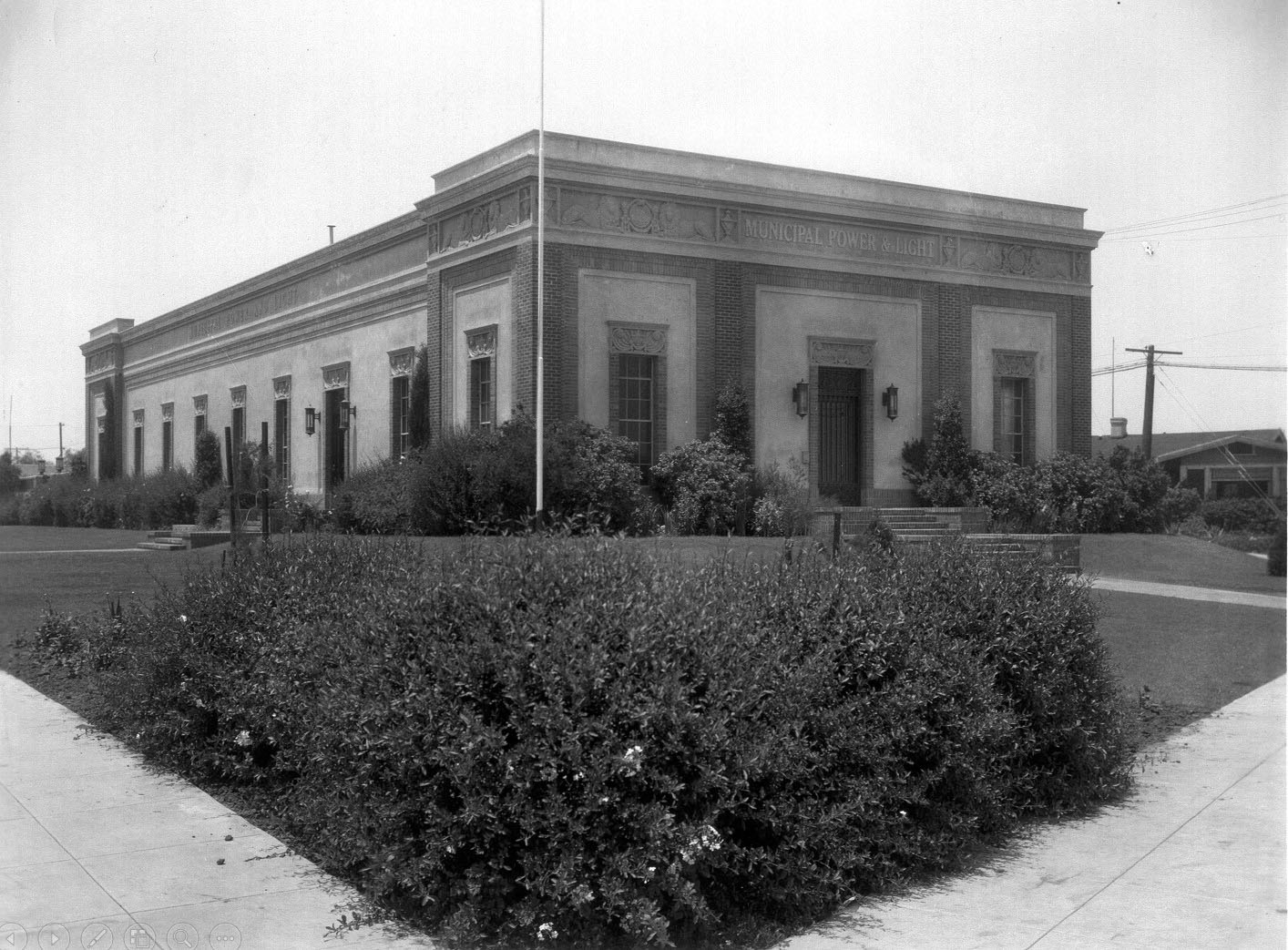 |
|
| (ca. 1930s)^^ – View showing DS-44 located at 911 Lincoln Blvd. |
Historical Notes Because it was considered a community landmark, a large amount of money was spent to preserve the exterior appearance of this station when it was seismically upgraded. There is now a wrought iron fence around the perimeter.^^ |
Distribution Station No. 46
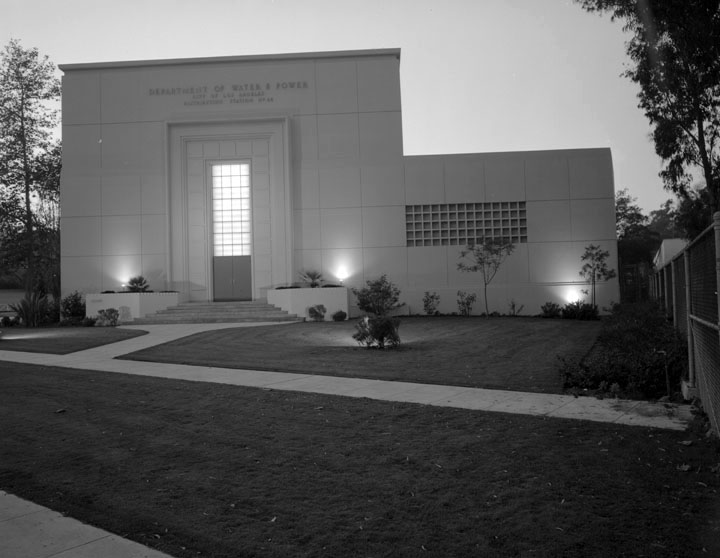 |
|
| (1955)* - Evening view of newly construction Distribution Station No. 46 located at 10295 Wilshire Blvd. |
Historical Notes August 1955 – Nearly 750 local residents, and a number of youth organizations attended an open house and public inspection of a modern electric distributing station arranged for Friday and Saturday, August 12 and 13, at 10295 Wilshire Blvd by the Department. Department personnel were on duty during the two-day exhibit to conduct individuals, church groups, civic clubs and other organizations on tours of the facility. Among specially invited guests inspecting the station during the open house were Councilman Charles Navarro, chairman of the Council’s Water and Power Committee; and Councilwoman Rosalind Wyman, part of whose fifth district is served by the facility. Other guests included approximately 100 youths, members of the YMCA, Boy Scouts, and Cub Scouts. Light refreshments were served the visitors by Department home economists, who also displayed and demonstrated a selection of the latest models of electric home appliances, such as ranges and refrigerators. Home economists participating were Loretto Ditlow, Dorothy Newotn, Patricia Feagans, Betty Mace, Epsie Franklin, and Assistant Home Economist Jane Steels. Known as Wilshire Distributing Station No. 46 this facility serves the Westwood and West Los Angeles Districts, including a large part of the territory from the Los Angeles-Beverly Hills line to Sepulveda Blvd, and from the Santa Monica Mountain area to the vicinity of Pico Blvd.** |
Distribution Station No. 52
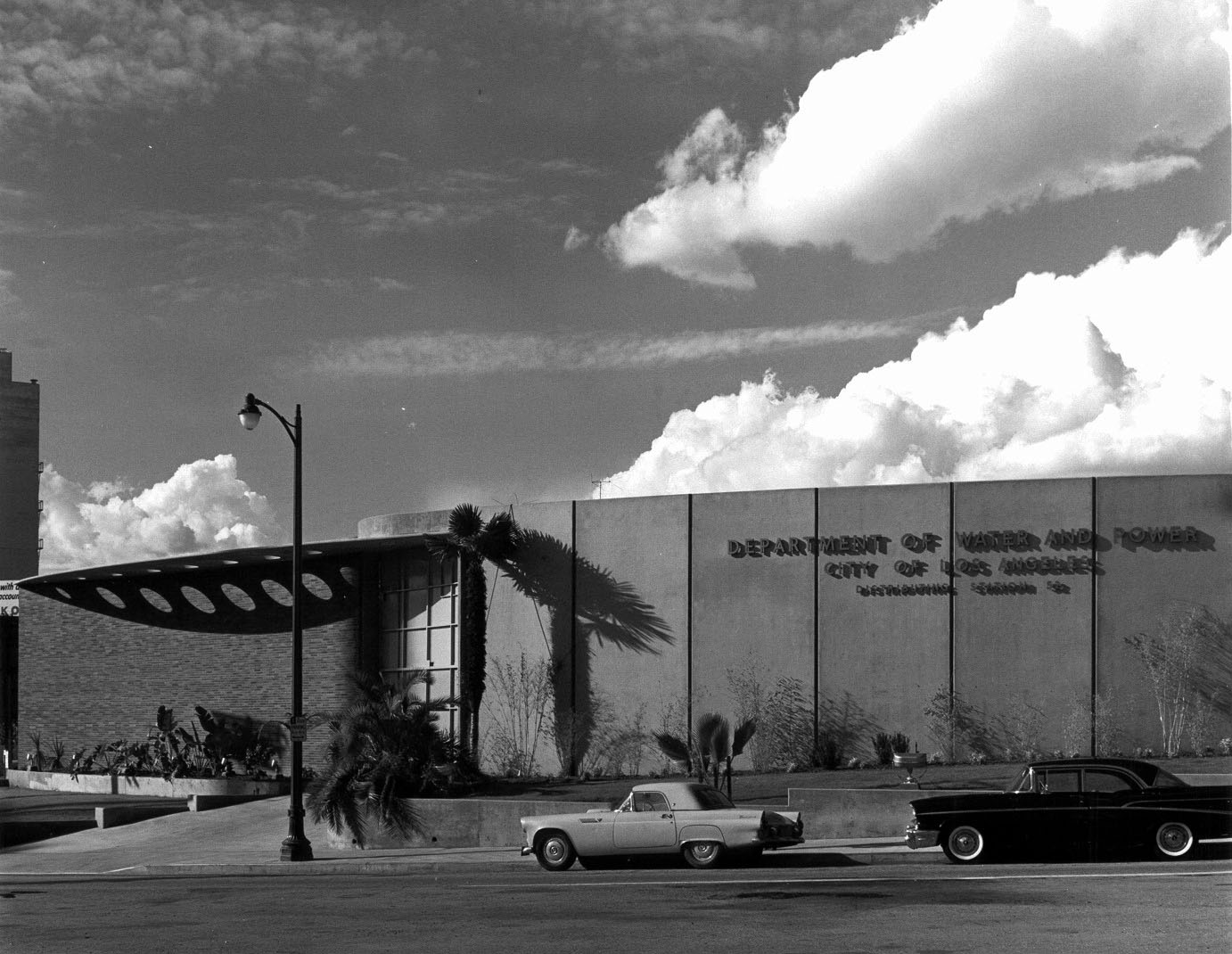 |
|
| (1960)^^ – View showing DS-52 located at 1821 Argyle Ave. |
Distribution Station No. 55
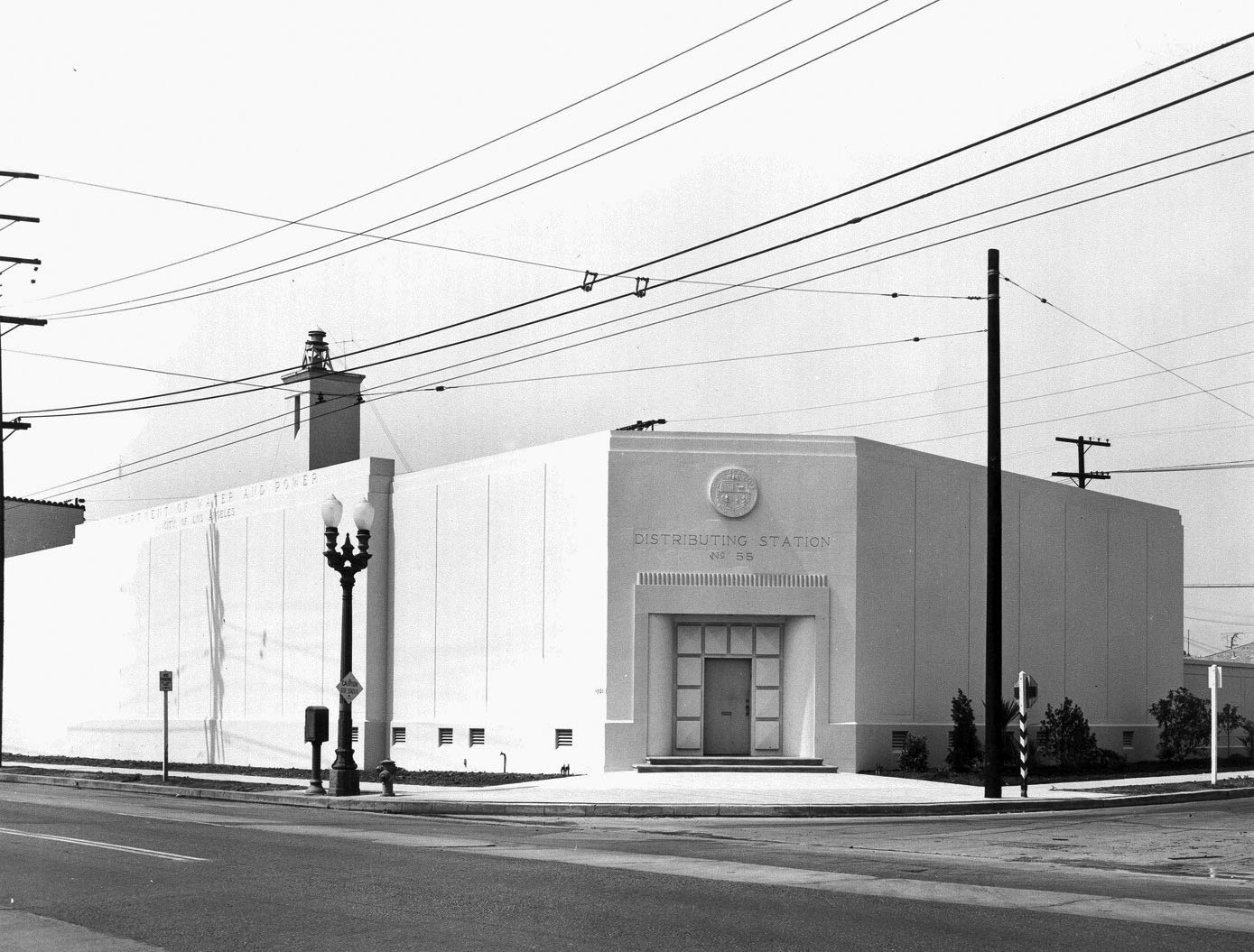 |
|
| (1953)^^ – View showing DS-55 located at 5801 W 3rd St. |
Historical Notes This time period also saw a new style of indoor station built in the Metro Areas - the ring bus stations (with metalclad Switchgear). The first ones were built in the early 50’s - DS-46, 53, 55 in WLA, 7 & 16 in Metro. DS-61, 75 & 76 came later.^^ |
Distribution Station No. 61
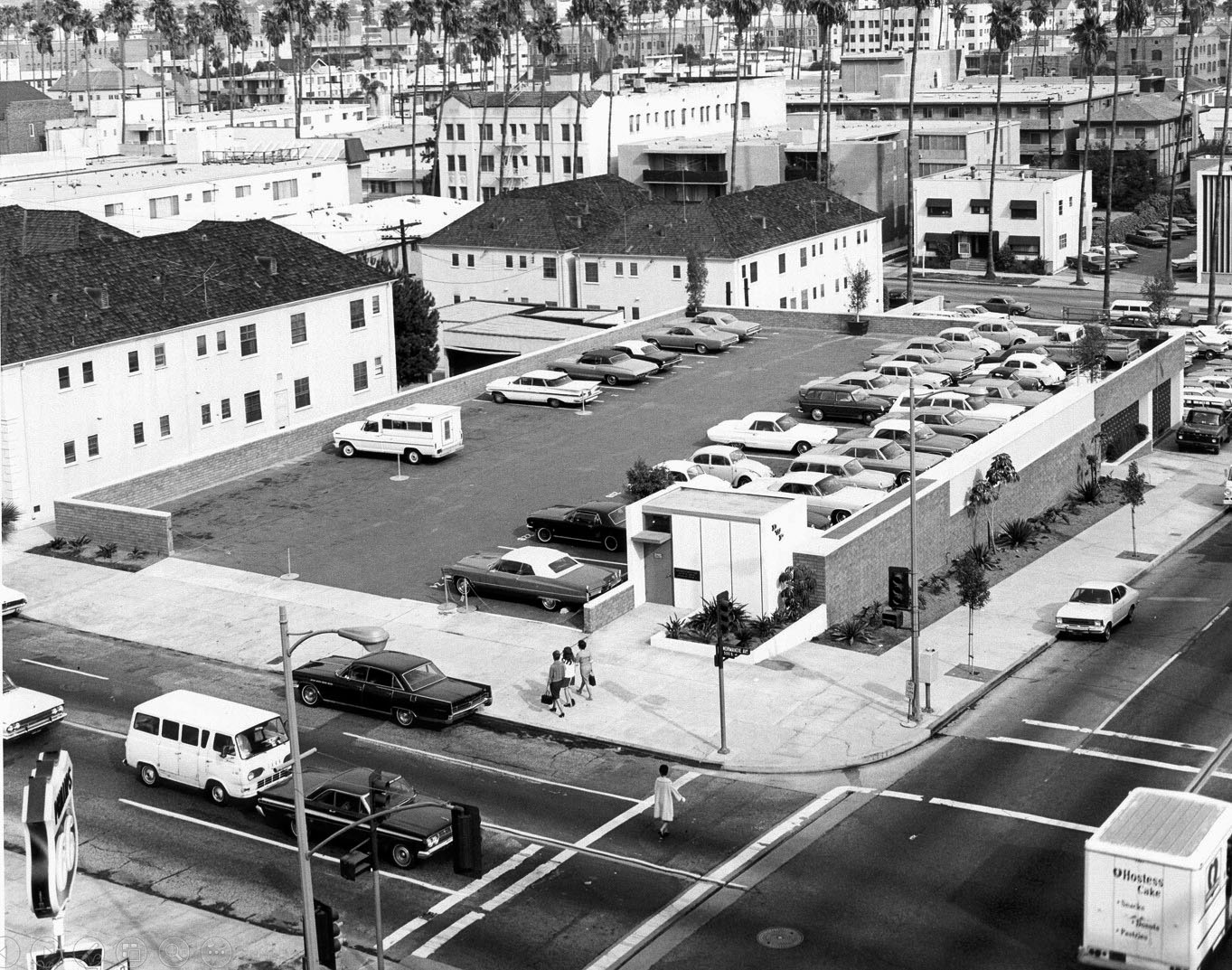 |
|
| (1968)^^ – View showing DS-61 located at 3569 W. 6th Street. |
Historical Notes DS-61 (and DS-16) have parking lots built over them. |
Distribution Station No. 64
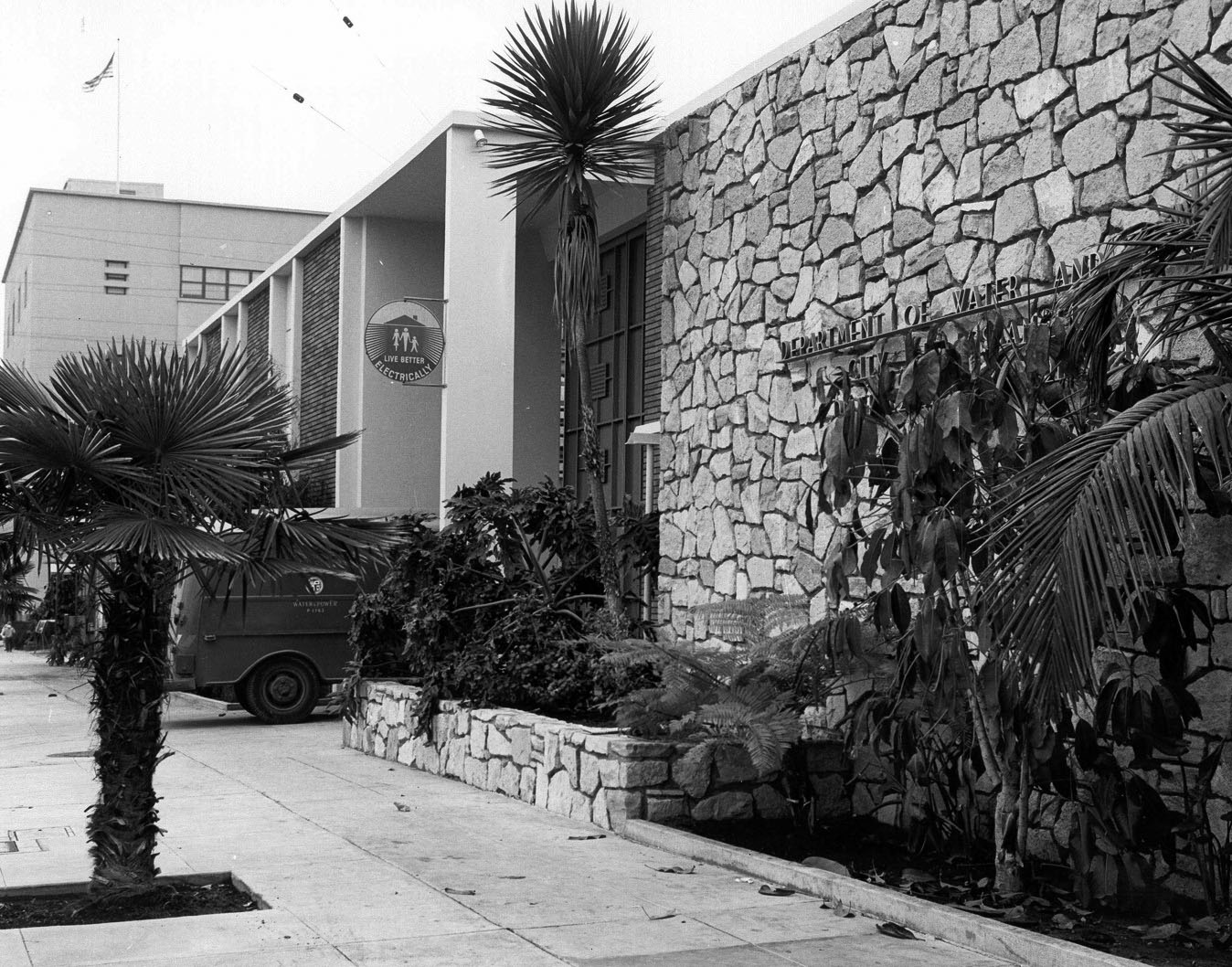 |
|
| (1963)^^ – View showing an early model truck parked in the driveway of DS-64 located at 14860 Ventura Blvd. |
Distribution Station No. 78
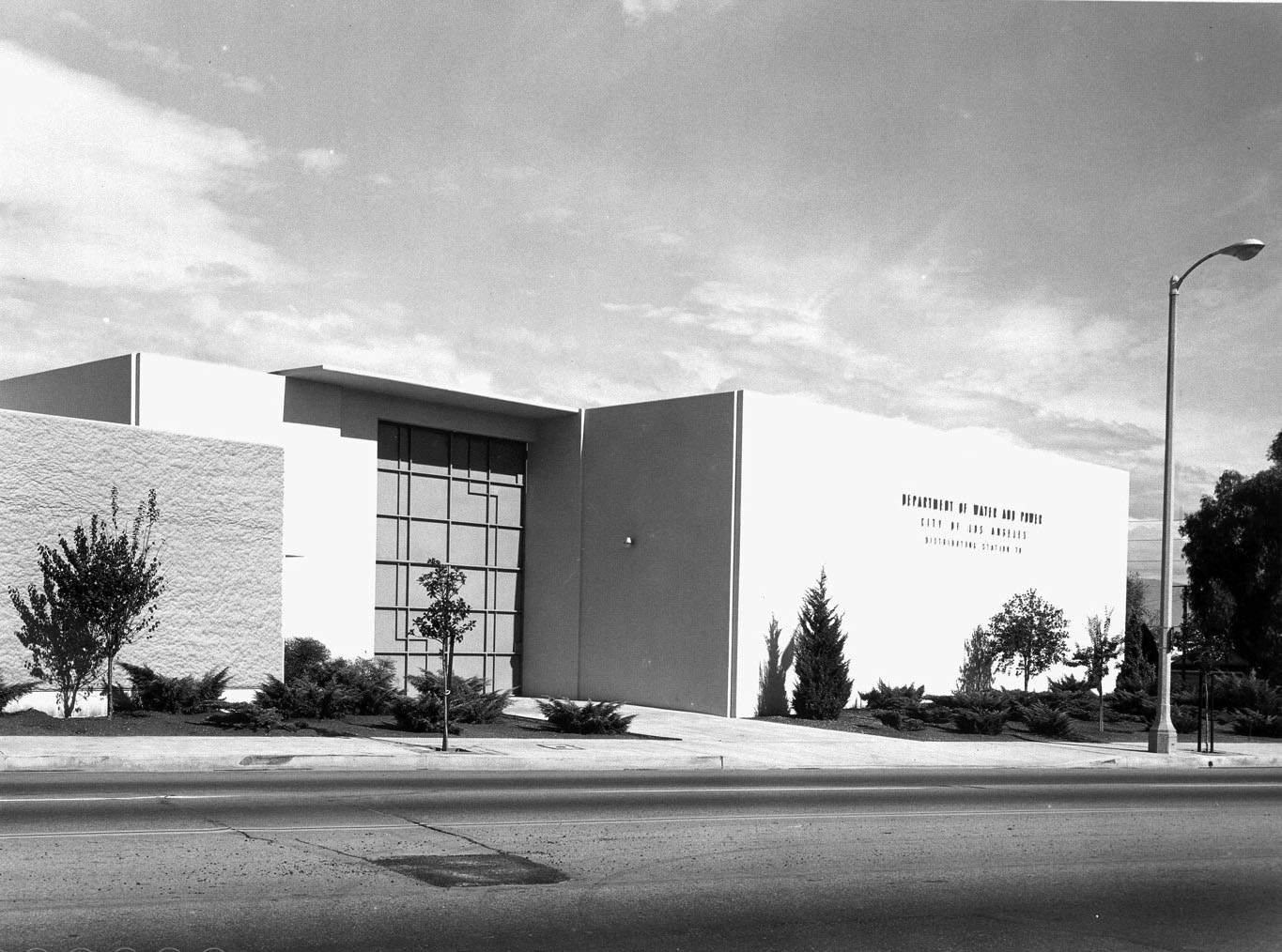 |
|
| (1969)^^ – View showing DS-78 located at 18033 Ventura Blvd. |
Early Portable Distribution Station
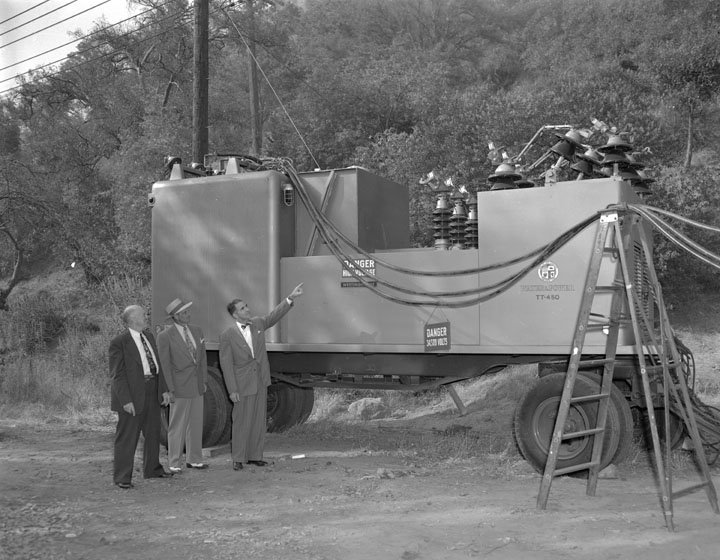 |
|
| (1952)* - T. M. Blakeslee, head of Operating division, is seen pointing out high-voltage switching equipment on new portable distributing station to Herbert H. Cox, left, and Floyd L. Goss. Cables are seen leading into DS No. 114, where alterations had just been completed by Design and Construction division workmen. Lines connecting mobile unit with overhead feeder had been removed just before photo was taken. |
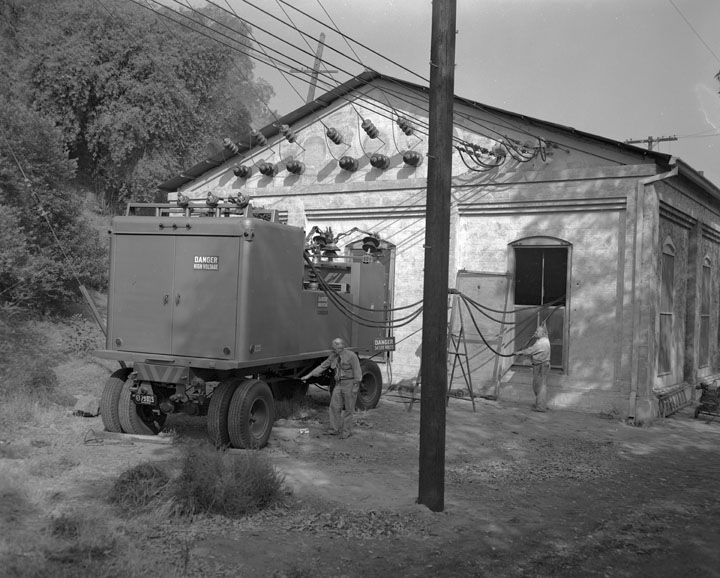 |
|
| (1952)* - View showing the portable distributing station being used as a sub-station. |
Click HERE to see more in Early Power Station Operations |
* * * * * |
References and Credits
* DWP - LA Public Library Image Archive
^^ DWP - Water and Power Associates Historical Archives - Courtesy of Rex Atwell
*^ Wiki: Synchronous Condenser
^* Facebook: SoCal Historic Architecture
*# Claremont Colleges Digital Library
..Electricity in Brick, Concrete, and Stone: DWP Distribution Stations No. 1-20
< Back
Menu
- Home
- Mission
- Museum
- Mulholland Service Award
- Major Efforts
- Board Officers and Directors
- Positions on Owens Valley and the City of Los Angeles Issues
- Legislative Positions on
Water Issues
- Legislative Positions on
Energy Issues
- Recent Newsletters
- Historical Op Ed Pieces
- Membership
- Contact Us
- Search Index